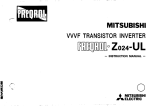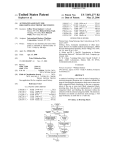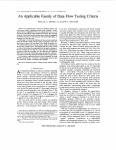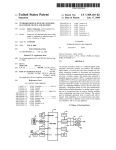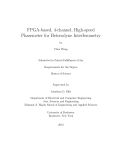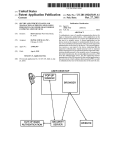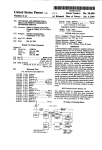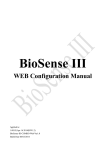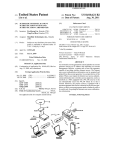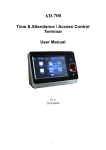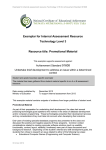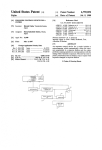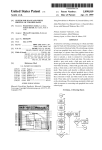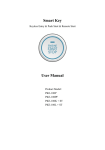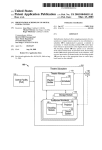Download Collection management database of arbitrary schema
Transcript
US 20030120673A1 (19) United States (12) Patent Application Publication (10) Pub. N0.: US 2003/0120673 A1 Ashby et al. (43) Pub. Date: (54) COLLECTION MANAGEMENT DATABASE (52) Jun. 26, 2003 Us. 01. ............................................................ .. 707/100 OF ARBITRARY SCHEMA (76) Inventors: Gary H. Ashby, Orem, UT (US); Marlo E. Schuldt, Orem, UT (US) (57) Correspondence Address? PATE PIERCE & BAIRD 215 SOUTH STATE STREET’ SUITE 550 Apparatus and methods for deterministically classifying and indexing objects that are perceived arbitrarily and subjec tively, such as digital media and ?le representations of PARKSIDE TOWER hoto ra hs in a database Auser establishes various er SALT LAKE CITY, UT 84111 (US) (21) App1_ No; ABSTRACT p .g p ’ . . ' . . p sonahZed descriptive category sets to organize media, such 10/327,578 as digital photographs, video, and audio. The descriptive category sets include categories to describe some aspect or (22) Filed: DEC- 20, 2002 _ attribute of the objects of the user. Each category may be _ arbitrarily de?nable and contain a ?nite number of descrip Related U‘S‘Apphcatmn Data tors, constituting values Within the category. Objects are (60) Provisional application No. 60/343,861, ?led on Dec. entered Him Collecnons by filténng the oblects accordmg to the descriptors of the descriptive category set. A user may . . . . . thus arbitrarily de?ne a schema of classi?cation according to 21, 2001. publication Classi?cation perceptions, links, experiences, and the like, according to the subjective memory, vocabulary, and mental connections of a (51) Int. Cl.7 ..................................................... .. G06F 7/00 52 50-\;]" 48\ r52 . Client Client 1 l | r52 Net Card f __ F r52 . r52 r54 Client Client Client Server I | i l /1‘i 16 30 i r52 . Router user. \ f20 \ \ J Storage Device (Read/Write) ‘ RAM )0 % [-18 1 ROM 1 26 4O 32 ,J 4" 4? “@Ql Cl _ 31 38 36 , Input D evi 0e IE Port Processor ‘:1 o o O HD / i ) 12 ) 46 _ Output . Device A / 24 E44 Patent Application Publication Jun. 26, 2003 Sheet 2 0f 11 US 2003/0120673 A1 ‘Entire‘Collection Q2 . j ' Collection A _ Collection B . , ‘ 6&1‘? Q55 Descriptive Category Set A $2 a, ‘ or ~ I > Collection C ' _____ Bit: Q52. Descriptive Category Set B 6—8Q Collection D gm Descriptive Category Set C Si Collection n Descriptive Descriptive Category Set D 6i 689 Category Set n _ FIG. 2 Patent Application Publication Jun. 26, 2003 Sheet 3 0f 11 1 72 Collection Generation Module 7_4 116 I createcouections . g E . c'assify objects g1 Descriptive Category Sets 6_8_ Captions 2 Other Criterion 8_4 v_ lew L C H Classification Module 118 Define Categories within E a ch set 122 K Add, Delete, Modify Category Sets, Categories, and Descriptors t_ 86 CD Creation Module __ Export objects 8_8_ Object Labe'ing E Collection Editing M odul 8 % Add, Delete, Modify 94 Objects in a Collection — Enhance Objects E Modify Classification 98 — Image Files 1_2_8 Thumbnail Files El 100 Viewing Software M Other Modules @ onlme User Manual 1E1 Context sensitive He|p m1 J Tutorials E1 1% Database Searching Module 104 Define Scope of Search 106 Descriptive Define Method Category of Search Sets _O_8_ Q Captions I Q I Other Criterion 8_4_] Initiate Search 11 0_| Display Search Results 112 Slide Show Module VLB @ 122 Classification Information 1_12 L Add, Delete, Modify Collections Object Label Editing [ | of Ob|ects in a Collection 11_8 Define Descriptors Within Each Category ll) o ec ions Thumbnail Generator 11_4 Define Descriptive Category Sets k“ Add Ob|ects to Collection 1Q US 2003/0120673 A1 1.5;; @111 f , ,I , _ 146 l ‘I '3‘,. l l ‘ Patent Application Publication Jun. 26, 2003 Sheet 4 0f 11 US 2003/0120673 A1 152 154 User Action-f Software Action / User Chooses a 156 collect'on type —— _--- Software Automatically References Corresponding Descriptive Category set ~~ 1_5_ l a Software Creates a Record in the '' User Creates a Collection Collections Table 1@ Q 1 Software Dynamically Creates \\ One or Several Tables \ (e.g. Modifies the Schema) to Store Data Corresponding \\ \ User_Popu_lates the 166 ~~"‘~ collect'on w'th objects ~~ " a Record for Each Object in “ss User Describes Objects in Terms of Captions, Descriptors, Dates, by way of the X‘ ‘ \ the Collection E 163 " Software Automatlcally Populates ~~‘ v Fields in the Tables E ‘ ‘ User Searches for Objects Having _“~~ a Specified Caption, Descriptor, Date, or Other Crlterlon m " software Automatica“ Y Navigates and searches the Entire Database , 1_Z_E_3 Without User Intervention \ V \ Software Searches From the Host , \ Computer's Memory, Secondary Memory, Peripheral Memory, . Network Resources, and the \ Internet for Objects Satisfying \‘ FIG. 4 164 Software Automatically Creates v Software Interface to the Collection the SpecIfIed Crlterlon @ Patent Application Publication Jun. 26, 2003 Sheet 5 0f 11 US 2003/0120673 A1 190\ Select Names for Each Descriptive Category Set l Select Categories to Include in Each Descriptive Category Set 1 Select Descriptors Within Each Category 1Q 194 FIG. 5 Patent Application Publication Jun. 26, 2003 Sheet 7 0f 11 Designate a Collection Name US 2003/0120673 A1 21 IN I Select Predefined Descriptive Category Set l Select Objects to Include in the Collection A CD IN 1 Classify Objects According to Descriptors in the Selected Descriptive Category Set 2.1. 1 If a Desired Descriptor is not Available, Add the Descriptor Desired and Classify the Obiect According to the Descriptor 220 FIG. 7 Patent Application Publication Jun. 26, 2003 Sheet 8 0f 11 US 2003/0120673 A1 .GEm a nww NO\ P $32 }5 mvm Jun. 26, 2003 US 2003/0120673 A1 fying and indexing objects, such as digital media and ?les, COLLECTION MANAGEMENT DATABASE OF ARBITRARY SCHEMA in a database, by a user based on deterministic and highly RELATED APPLICATIONS provided a database, such as a relational or associative [0001] This patent application claims the bene?t of US. Provisional Patent Application Serial No. 60/343,861 ?led needed as a user desires to add and organiZe additional arbitrary and fuZZy logic of a user’s mind. A user may be Dec. 21, 2001 and entitled Associative Distributed Database of Arbitrary Schema. BACKGROUND [0002] 1. The Field of the Invention [0003] This invention relates to computer softWare and, more particularly, to novel systems and methods for orga niZing and retrieving objects such as digital photographs, images, audio recordings, video recordings, or other ?les stored in databases. [0004] 2. The Background Art [0005] The emergence and proliferation of electronic devices, such as digital cameras, video recorders, music database. The database may be dynamically expandable as media to a collection. At the outset, the invention recogniZes that many associations and decisions are used naturally by the mind to discriminate betWeen (sort) various objects, especially something With so many complex memories bound to it, like a photograph has. Although digital photo graphs are referred to repeatedly in the body of this speci ?cation, one of ordinary skill in the art Will recogniZe that apparatus and methods in accordance With the invention may be used to organiZe, associate, and store other digital media and objects such as images, digital video recordings, digital audio recordings, digital text ?les, and the like, and are intended to be captured Within the scope of the present invention. [0010] A user may con?gure and set up a database in players, and other computing devices, has made the storage accordance With the invention Without having expertise and training in database systems. Apparatus and methods in of digital images, as Well as other forms of digital video, audio, ?les, and the like, more common, inexpensive, and accordance With the invention may provide a user the ability to establish various descriptive category sets to organiZe the convenient. Due to the decreased expense and increased convenience, a user may acquire these types of media and ?les more easily and in increased numbers. With these media. For example, a user may create a descriptive cat egory set With one or a plurality of categories to categoriZe increased numbers, means of organiZing and cataloging the used to describe some aspect or attribute of the objects. In a group of objects unique to the user. Each category may by media in a manner that the media may be effectively addition, each category may be arbitrarily de?nable by a catalogued, classi?ed, searched, associated, and retrieved is user to contain a ?nite number of descriptors, constituting values Within the category. an important issue. [0006] Digital media organiZers, albums, and the like, typically lack the poWer to effectively store, catalog, asso [0011] Once a user has established descriptive category sets according to an organiZation scheme selected by the ciate, and search vast numbers of media ?les or other ?les. Moreover, many include user interfaces that are nonintui user, a user may select objects, such as digital media and tive, lack intuitive methods to organiZe the media, and do not provide a user the ability to easily con?gure and personaliZe the interface. [0007] What is needed is an intuitive, easy to use, poW ?les, having attributes perceived by a user to correspond to the descriptive category set. Each object may be uniquely identi?able by a user and also be identi?ed by a unique identi?er retrievable by a computer (eg ?le name, etc.). The user may then select a descriptive category set that he or she erful database system to effectively catalog, store, associate, considers to correspond to the perceived attributes of the search, and retrieve digital media and ?les so that they are objects. A user may create sets by the user’s oWn mental readily accessible and easily manipulated by an unsophisti associations and de?ne categories, sets, and ?elds With Words arbitrarily selected due to their unique signi?cance to cated user. the user. [0008] What is further needed is a method to arbitrarily classify and associate photographs With key Words and phrases that may be selected and personaliZed by a user on the ?y, on any “soft” or hard basis (e.g., logic), thereby providing the features and advantages of an associative database and yet of a pseudo “arti?cial intelligence” or “fuZZy logic” connection scheme (e.g. association). More over, What is further needed is a poWerful search engine Which may quickly locate photographs according to pre de?ned search parameters corresponding to the keys Words and phrases previously selected obtaining the bene?t of highly deterministic systems, yet bene?tting from the highly developed, inherent, “fuZZy logic” types of associations available to a user by virtue of the normal operation of the human brain. SUMMARY OF THE INVENTION [0009] A primary object of the present invention is to provide apparatus and methods for deterministically classi [0012] The user may create a collection of objects having a collection name and the collection may be characteriZed by a type corresponding to the selected descriptive category set. Once the collection is established, the user may enter objects into the collection by linking selected ones of the objects With the collection name and by ?ltering the objects accord ing to correspondence of the attributes of the objects to the descriptors of the descriptive category set. The correspon dence of the attributes to the descriptors perceived by a user may be highly subjective and seemingly arbitrary. Never theless, a user is typically relying on a complex schema of mentally associated characteristics and memories associated With a picture. [0013] Once the objects have been linked to the descrip tors, information identifying the descriptors, categories, and the selected category set may be stored in a database. This information may facilitate future searching for collections, or objects in the collections. Jun. 26, 2003 US 2003/0120673 A1 [0014] In certain embodiments, the descriptive category [0023] set may be modi?ed to include additional categories “on the ?y” in response to the presentation of a neW object having attributes not conforming to any of the available categories, ment of descriptive category sets, descriptive categories, and descriptors used to categoriZe objects; or having attributes that are better described With an addi tional or alternate category. These may change as a user’s [0024] FIG. 6 is a How diagram illustrating one embodi FIG. 7 is a How diagram illustrating one embodi ment of a process for classifying objects to be included in a mind considers, consciously or subconsciously, over time collection; the object (e.g., photograph) in the conteXt of memories and signi?cance it elicits due to mental associations. Likewise, [0025] FIG. 8 is a How diagram illustrating one embodi ment of a process for ?ltering objects With respect to several additional descriptors may be added to any or all of the descriptive category sets in accordance With the invention; descriptive categories to better describe an object included in a collection. [0015] Apparatus and methods in accordance With the invention may provide for searching for collections or objects in a collection using a descriptive category set. A user may select a search criteria such as a descriptor, category, or set, perceived by a user and de?ned thereby to correspond to attributes of desired objects. In accordance With the invention, the user may then initiate a search of the objects according to the search criteria. The desired objects may then be retrieved to create a subset of the objects [0026] FIG. 9 is a How diagram illustrating one embodi ment of the organiZation of data in database tables in accordance With the invention; [0027] ment of egories, With the FIG. 10 is a How diagram illustrating one embodi the organiZation of descriptive category sets, cat and descriptors in database tables in accordance invention; and [0028] FIG. 11 is a How diagram illustrating one embodi ment of a process for searching for objects categoriZed in accordance With the invention. corresponding to the search criteria. [0016] Apparatus and methods in accordance With the invention may provide the ability to broWse objects in any or all of the collections. In addition, the descriptors, catego ries, or descriptive category set of a speci?c object may be modi?ed When entering an object into a collection, broWsing a collection, or after searching the collections. Additionally, information used to indeX and categoriZe the objects need not be limited to the descriptive category set, categories, and descriptors. Each object in a collection may be indeXed and identi?ed With other information arbitrarily selected by a user for a reason unique to the user such as captions, dates, events, and the like. BRIEF DESCRIPTION OF THE DRAWINGS [0017] The objects and features of the present invention Will become more fully apparent from the folloWing descrip tion, taken in conjunction With the accompanying draWings. DETAILED DESCRIPTION OF THE PREFERRED EMBODIMENTS [0029] It Will be readily understood that the components of the present invention, as generally described and illustrated in FIGS. 1 through 11 herein, could be arranged and designed in a Wide variety of different con?gurations. Thus, the description herein is not intended to limit the scope of the invention, but is merely representative of certain presently preferred embodiments of devices and systems in accor dance With the invention. Those of ordinary skill in the art Will, of course, appreciate that various modi?cations to the details herein may easily be made Without departing from the essential characteristics of the invention, as described. Thus, the folloWing information is intended only by Way of eXample, and simply illustrates certain presently preferred embodiments consistent With the invention. Understanding that these draWings depict only typical [0030] The presently preferred embodiments of the inven embodiments of the invention and are, therefore, not to be tion Will be best understood by reference to the draWings, Wherein like parts are designated by like numerals through considered limiting of its scope, the invention Will be described With additional speci?city and detail through use of the accompanying draWings in Which: [0018] FIG. 1 is a schematic block diagram of one embodiment of computer hardWare that may be used to implement an apparatus and method in accordance With the invention; [0019] FIG. 2 is a schematic block diagram illustrating one embodiment of a creation process for creating collec tions associating a group of objects; [0020] FIG. 3 is a schematic block diagram of one embodiment of modules included in a collection manage ment system in accordance With the invention; [0021] FIG. 4 is a How diagram of one embodiment of user actions and corresponding softWare actions in accor dance With the invention; [0022] FIG. 5 is a How diagram illustrating one embodi ment of a process Whereby descriptive category sets may be created to categoriZe objects in accordance With the inven tion; out. [0031] Referring to FIG. 1, an apparatus 10 may imple ment the invention on one or more nodes 11, (client 11, computer 11) containing a processor 12 (CPU 12). All components may eXist in a single node 11 or may eXist in multiple nodes 11, 52 remote from one another. The CPU 12 may be operably connected to a memory device 14. A memory device 14 may include one or more devices such as a hard drive or other non-volatile storage device 16, a read-only memory 18 (ROM 18) and a random access (and usually volatile) memory 20 (RAM 20 or operational memory 20). [0032] The apparatus 10 may include an input device 22 for receiving inputs from a user or from another device. Similarly, an output device 24 may be provided Within the node 11, or accessible Within the apparatus 10. A netWork card 26 (interface card) or port 28 may be provided for connecting to outside devices, such as the netWork 30. [0033] Internally, a bus 32, or plurality of buses 32, may operably interconnect the processor 12, memory devices 14, Jun. 26, 2003 US 2003/0120673 A1 input devices 22, output devices 24, network card 26 and port 28. The bus 32 may be thought of as a data carrier. As such, the bus 32 may be embodied in numerous con?gura tions. Wire, ?ber optic line, Wireless electromagnetic com munications by visible light, infrared, and radio frequencies a plurality of collections 66a-e. The sorting may be custom iZed or personaliZed according to criteria 68a-e for each collection established by a user having, oWning, or being associated in some Way With the objects 62. The user may may likewise be implemented as appropriate for the bus 32 and the netWork 30. establish various descriptive category sets 68a-e in order to classify or catalog each of the objects 64 in each of the collections 66. [0034] Input devices 22 may include one or more physical embodiments. For eXample, a keyboard 34 may be used for [0041] For eXample, a ?rst collection 66a may contain digital photographs related to a particular event, such as a interaction With the user, as may a mouse 36 or stylus pad 37. A touch screen 38, a telephone 39, or simply a telecom family vacation. Accordingly, a descriptive category set 68a may be used to categoriZe and indeX photographs 64a, 64b, munications line 39, may be used for communication With for eXample, related to “vacations.” LikeWise, a second collection 66b may use a second descriptive category set 68b used to categoriZe photographs 64c, 64d relating to a holi other devices, With a user, or the like. Similarly, a scanner 40 may be used to receive graphical inputs, Which may or may day. not be translated to other formats. The hard drive 41 or other memory device 41, such as a CD ROM or DVD drive, may be used as an input device Whether resident Within the node [0042] 11 or some other node 52 (eg 52, 54, etc.) on the netWork 30, or from another netWork 50. using identical or different descriptive category sets 68c-e. Each of the collections 66 may include photographs 64 in Similarly, additional collections 66c-e may be used to categoriZe other photographs 64 into logical groupings Output devices 24 may likeWise include one or common With other collections 66 or each may contain more physical hardWare units. For eXample, in general, the port 28 may be used to accept inputs into and send outputs from the node 11. Nevertheless, a monitor 42 may provide photographs 64 unique to a speci?c collection 66. In certain embodiments, additional collections 66d, 666 may be cre ated from eXisting collections 66a, 66b, 66d. Each of these [0035] outputs to a user for feedback during a process, or for collections 66d, 666 may be characteriZed by unique assisting tWo-Way communication betWeen the processor 12 descriptive category sets 68d, 686, or may share a descrip tive category set 68d, 686 With another collection 66a-c. and a user. Aprinter 44, a hard drive 46, or other device may be used for outputting information as output devices 24. [0036] In general, a netWork 30 to Which a node 11 connects may, in turn, be connected through a router 48 to another netWork 50. In general, tWo nodes 11, 52 may be on a netWork 30, adjoining netWorks 30, 50, or may be sepa rated by multiple routers 48 and multiple netWorks 50 as individual nodes 11, 52 on an internetWork. The individual nodes 52 (eg 11, 48, 52, 54) may have various communi cation capabilities. [0037] In certain embodiments, a minimum of logical capability may be available in any node 52. Note that any of the individual nodes 11, 48, 52, 54 may be referred to, as may all together, as a node 11 or a node 52. Each may contain a processor 12 With more or less of the other components 14-46. [0038] A netWork 30 may include one or more servers 54. Servers may be used to manage, store, communicate, trans fer, access, update, and the like, any practical number of ?les, databases, or the like for other nodes 52 on a netWork 30. Typically, a server 54 may be accessed by all nodes 11, 52 on a netWork 30. Nevertheless, other special functions, including communications, applications, directory services, and the like, may be implemented by an individual server 54 [0043] Referring to FIG. 3, one embodiment of a collec tion management system 72 may be embodied as softWare data structures to be executed or processed on a computer 11. The collection management system 72 may include a collection generation module 74, a collection editing module 92, a searching module 104, a classi?cation module 114, a CD creation module 124, a database 144, a database engine 145, a slide shoW module 148, as Well as other modules 136. [0044] A collection generation module 74 may include a module 76 for creating collections 66. For eXample a module 76 may provide a user the ability to name a collection 66, select a descriptive category set 68 corresponding to the collection 66, and import or scan objects 64, such as photographs 64, into a collection 66. As photographs 64 are imported into a collection 66, they may be identi?ed or classi?ed according to the descriptive category set 68 cor responding to the collection 66. [0045] For eXample, a collection generation module 74 may include a module 80 for classifying or categoriZing photographs 64 as they are imported into a collection 66. A user may initially select 68 a descriptive category set 68, having categories and descriptors that the user deems most appropriate for a given group of photographs 64. The user over a netWork 30 With a server 54, a router 48, or nodes 52. may also enter a caption 82 to each of the photographs 64 in the collection 66. In certain embodiments, the user may also be able to enter an additional teXt description of any arbitrary length corresponding to a desired object, or collection. The Similarly, a node 11 may need to communicate over another netWork (50) in an internetWork connection With some caption 82 may or may not be independent from the descrip tive category set 68, selected to classify the group of remote node 52. LikeWise, individual components 12-46 photographs 64. LikeWise, a user may select other criterion may need to communicate data With one another. A com munication link may eXist, in general, betWeen any pair of 84 to classify any or all of the photographs 64. For eXample, each photograph 64 may be assigned a date, may be linked devices. to another media or other ?le, or be assigned some other [0040] Referring to FIG. 2, a group 62 of objects 64, such as digital photographs 64, video recordings 64, audio record identifying criterion 84. [0046] The collection generation module 74 may provide ings 64, teXt ?les 64, and the like, may be sorted into one or the capability to broWse 86 or vieW 86 a collection 66 once or multiple servers 54. [0039] In general, a node 11 may need to communicate Jun. 26, 2003 US 2003/0120673 A1 created. Objects 64 in the collection 66 may be viewed in any particular order, such as the order objects 64 Were imported into a collection 66, in order of siZe, date, date last modi?ed, or by some other ordering method. In certain embodiments, smaller thumbnails of each photograph 64 may be displayed so a user may easily broWse through a collection 66. The thumbnail photographs may be created by a thumbnail generator 88 for each photograph 64 as it is imported into a collection 66. [0047] In certain embodiments, the collection generation editing module 92, but indexing information, such as cap tions 82, indexing from corresponding descriptive category set 68, labeling performed by a labeling module 90, and other information 84, may be edited 98. The user may also directly edit 100 collections, such as by changing a name of a collection 66, changing a corresponding descriptive cat egory set 68, deleting objects 64 Within a collection 66, or adding, modifying, or deleting a collection 66. The user may also edit 102 an object’s labeling, such as by adding, deleting, or modifying the labels, and the like. module 74, or some other module, may include an object [0052] labeling module 90. For example, in the case of digital photographs 64, a photograph 64 may contain details that may not be easily described using a descriptive category set 68, captions 82, or using another criterion 84. For example, a searching module 104. A user may be required to de?ne The collection management system 72 may include 106 a scope of a search. For example, a user may desire to search all collections 66 or may desire to search only a photograph 64 of a family reunion may include many individual or groups of collections 66. Once the user has de?ned the scope of the search, a user may identify 108 a persons Within the photograph 64. A caption 82 or descrip tive category set 68 may be inadequate to index or identify each person in the photograph 64. keyWords from object captions 82, terms used to classify objects 64 using descriptive category sets 68, or search using [0048] Therefore, an apparatus and method in accordance With the invention may provide the capability to label persons, objects, or other elements, associated With locations on the surface of a digital image 64. In certain embodiments, this labeling information may be stored in another ?le separate from the digital image ?le 64. The labels may be placed on or near each of the persons, objects, or items of interest. In certain embodiments, the labels may be selec tively displayed or hidden so that a user may vieW the method of searching. For example, a user may search using some other criterion, such as an object’s date, siZe, name, ?le type, last modi?ed date, or the like. [0053] Once a user has established a scope and a method of search, a search may be initiated 110. The searching module 104 may then display 112 the results of the search. This may include providing a list of names of located objects 64, permitting a user to scroll through located objects 64, providing a list of thumbnails of located objects 64, or the like. contents of the photograph 64 behind the label. In selected embodiments, the labels may be selectively displayed or [0054] The collection management system 72 may include hidden When a user moves a cursor over the corresponding a classi?cation module 114. The classi?cation module 114 may alloW a user to establish and de?ne descriptive category object 64 identi?ed by the label. The labels may provide the capability to label many items or persons of interest Within a photograph, adding considerable information to a photo graph 64 that may be vieWed or searched at a later time. [0049] The collection management system 72 may include a collection editing module 92 for editing objects 64 in the collections 66. For example a module 94 may provide the ability to add, delete, modify, move, or provide some other editing capability of objects 64 in the collections 66. In sets 68 in order to classify and categoriZe objects 64 Within each collection 66. A user may initially establish 116 a descriptive category set by assigning it a name or type. For example, if a user possesses many photographs 64 of his or her family history, the user may desire to name a descriptive category set “family history.” The user may then de?ne 118 categories Within a descriptive category set 68. [0055] For example categories 118 Within a descriptive certain embodiments, a user may be able to edit 96 or category set 68 may include “people,”“places,” and “occa enhance 96 particular objects 64 in a collection 66. For example, in the case of photographs 64, a user may be able sions.” Each category may be helpful in describing photo graphs 64 related to family history. Within each category to perform editing features such as changing the brightness, contrast, color, ?lters, tint, and the like, to photographs 64 118, a user may de?ne descriptors (e.g. values Within the category). For example, under the “people” category, a user may include descriptors such as “cousins,”“couples,” and Within the collections 66. [0050] In certain embodiments, choosing to enhance 96 or edit 96 a photograph 64 Within the collection management system 72 may automatically open an editing application, such as Photoshop, Without having to manually exit the collection management system 72 softWare and manually open the editing softWare. In addition, When a user has ?nished using the editing application, a user may be returned directly to the collection management system 72 softWare in the same manner. An enhanced or edited photograph 64 may be saved directly over a previous unedited version, or a neW enhanced version may be saved in the collection 66 in addition to the previous version. In selected embodiments, a user may be able to reverse editing changes made but not desired later. [0051] In addition, not only may objects 64, such as photographs 64, be physically edited Within the collection “children.” Within the “places” category, a user may include descriptors such as “home,”“back yard,” and “park.” Like Wise, Within the “occasions” category, a user may include descriptors such as "vacation,”“holiday,” and “family reunions.” [0056] Descriptive category sets 68, once established, may be edited as needed by a user. For example, a user may choose to add an additional category 118. LikeWise, a user may choose to add descriptors Within any or all of the categories 118. [0057] In certain embodiments, categories and descriptors may be selected from preestablished lists by a user. For example, a user may choose categories from a list of categories to include in a descriptive category set 68. Like Wise, a user may choose descriptors from a preestablished list of descriptors to include as values Within a particular Jun. 26, 2003 US 2003/0120673 A1 category. A user may add to or delete from these lists of categories and descriptors as desired. [0058] The collection management system 72 may include a compact disk (CD), or other type of computer-readable media associated With the creation module 124. The com cesses of the collection management system 72. For example, tutorials 142 may include video or audio record ings detailing methods of operation of any or all of the modules Within the collection management system 72. The user may also be led through a series of steps or be asked to pact-disk creation module 124 may provide a convenient respond to questions to assist in the learning process. process to export objects 64 from collections 66 onto a [0064] computer-readable medium for sharing, backing up, archiving, and the like. [0059] In certain embodiments, the compact disk creation The collection management system 72 may include a database 144 to index and classify each of the objects 64 and collections 66. The database 144 may be con?gured as module 124 may provide a user the option to select objects needed to conserve memory resources and may be dynami cally expanded or contracted as needed as objects 64 or 64, collections 66, or groups thereof to burn or copy onto collections 66 are added or deleted by a user, or as additional computer-readable media. This may be accomplished by indexing information is added or deleted for each of the objects 64 or collections 66. In certain embodiments, the exporting 126 objects 64 or collections 66, such as image ?les 128, to a speci?ed folder that may be burned onto a database 144 may include tables 146 to store or index compact disk, or other computer-readable media, using appropriate softWare. In addition, in certain embodiments, information. One Will recogniZe that tables 146 in a database 144 may be con?gured and related in many Ways to store information related to the objects 64 and collections. the module 124 may export thumbnail ?les to the folder so a user may previeW images 64 in a compressed format before vieWing an entire image 64. Indexing information 132 may also be exported to provide a user the ability to search the exported objects 64, or images 64, using the descriptive category sets 68, captions 82, and other criteria 84 that Was previously associated With a particular object 64, or image 64. [0060] In certain embodiments, vieWing softWare 134 may be exported With the exported objects 64, or images 64, to provide a method for vieWing the objects 64 and collections. The vieWing softWare 134 may include a subset of the features provided by the collection management system 72. For example, the vieWing softWare 134 may alloW a user to search and display the collections 66 or objects 64 on exported media. HoWever, the user may not be able to create or edit any of the objects 64 using the vieWing softWare 134. The features included With or lacked by the vieWing soft Ware 134, compared to the collection management system 72, may be adjusted as needed. [0061] The collection management system 72 may include other modules 136 to perform various functions and tasks. For example, the system 72 may include an online user manual 138. This may simply be a link to a Web site on the Internet providing assistance for the system 72 or may doWnload information as needed or requested by a user. This method may provide a convenient solution to provide updated assistance for the collection management system 72. [0062] In other embodiments, the other modules 136 may include a context sensitive help module 140. This module 140 may detect features that a user is using at a time he or she requests assistance. For example, if a user is using the collection generation module 74 and is creating a collection 76, selecting the context sensitive help 140 may automati cally display a section of a user manual related to creating collections 76. LikeWise, if the user is using some other features of the collection management system 72, the user may be directed to the appropriate section of a help manual or to other material addressing the user’s issue. The context sensitive help module 140 may respond according to a [0065] The collection management system 72 may include a database engine 145 to interface With the database 144. The database engine 145 may be used to store, retrieve, and query the database 144 as needed. In addition, a slide shoW management module 148 may be used to create slide shoWs of the objects 64 and collections 66. Slide shoWs may be made up of objects 64 Within a collection 66, entire collec tions 66, or objects 64 across several collections 66. The slide shoW module 148 may be integrated seamlessly With the collection management system 72 so a user may create slide shoWs Without being required to exit the collection management system 72. [0066] Referring to FIG. 4, an apparatus and method in accordance With the invention may be characteriZed by actions 152 that a user may perform and actions 154 that the collection management system 72 may perform in response thereto. For example, a user may choose 156 an appropriate collection type in order to classify a group of objects 64. In response, the collection management system 72 may auto matically select 158 a descriptive category set 68 that corresponds to the collection type and display, to the user, the categories and descriptors to classify the objects 64. [0067] Once the user has selected 156 a collection type, a user may create 160 a collection 66 by giving it a name. In response, the the collection management system 72 may automatically add 162 a record corresponding to the neWly created collection 66 to a database table 146 listing existing collections 66. The the collection management system 72 may then automatically create 164 a table 146, or plurality of tables 146, in the database 144, corresponding to the neWly created collection 66, to list each of the objects 64 included therein. [0068] LikeWise, a user may choose 166 to populate the tables 146 created in step 164 With objects 64. As the user populates the tables 146 With objects 64, the the collection management system 72 may automatically create 168 a record corresponding to each object 64. This record may be used to store indexing and identi?cation information corre screen a user is using or, alternatively, the module 140 may sense Where a user is Within a particular process and respond sponding to the object 64. accordingly. of the descriptors of the descriptive category set 68, captions [0063] 82, and other criterion 84. The collection management system 72 may then automatically store 176 this information In selected embodiments, other modules 136 may include tutorials 142 to guide a user through selected pro [0069] The user may describe 170 the object 64 in terms Jun. 26, 2003 US 2003/0120673 A1 in each record or may store the information in another table 146 or record that is linked to the record. [0070] Likewise When a user searches for one or several objects 64 or collections 66, the user may specify descriptors 120, captions 82, or other criterion 84 corresponding to desired objects 64 or collections 66. The collection man agement system 72 may automatically navigate 176 and search 176 the entire database 144 Without requiring the user to personally navigate the database 144. The collection management system 72 may search 180 the host computer’s memory 14, as Well as netWork resources 30, and the Internet in certain embodiments, for objects 64 satisfying the criterion speci?ed by the user. [0071] Each of the steps 156, 160, 166, 170, 174 may be performed by the user in any order, or steps may be deleted or added as needed. Likewise, the steps 158, 162, 164, 168, 172, 176, 180 simply represent examples of certain embodi ments of actions 154 that may be performed by the collec tion management system 72 in accordance With the present invention and are not intended to limit the scope thereof. [0072] Referring to FIGS. 5 and 6, a process 190 for establishing descriptive category sets 68 may include ini tially selecting 116 names for each set 68. For example, descriptive category sets 68 may, for example, be given names like “album,”“family history,” or “fun photos,” as illustrated in FIG. 6. Once a name has been assigned 116 to a set 68, categories 198 may be selected for each set. For example, With respect to the “album” descriptive category set 68, categories 198 may be selected such as “people, example, referring speci?cally to FIG. 8, if a user has a collection of photographs 64a-g, the user may choose to divide them into one or more collections 66. A ?rst collec tion 66 may be organiZed using a ?rst descriptive category set 68a and a second collection 66 may be organiZed using a second descriptive category set 68b. With respect to the ?rst collection 66 and corresponding descriptive category set 68, photographs 64a, 64b, 64c, 64d, 64f may be ?ltered through the categories 198a-e such as, for example, one related to transportation or vehicles. A?rst category 198a, in this example, may be labeled With an identi?er like “vehicle” With descriptors 202a Within the category 198a. LikeWise another category 198b may be designated With another identi?er like “make” With corresponding descrip tors. Thus a user, may create his or her oWn descriptive category sets 68 to describe objects 64, such as photographs 64, that are unique to the user. [0076] In a similar manner, photographs 64d, 646, 64g may be sorted into another collection 66 using a distinct descriptive category set 68b. In this example, categories 198f-j such as, for example, the category “landscape,” having descriptors 202b, and the category “season” may be used to describe outdoor photographs 64d, 646, 64g. In addition, each of the photographs 64a-j may be designated With a caption 82a, 82b, as discussed previously, as Well as With other criteria 84a, 84b, such as a date. Each of the objects 64 may be indexed and associated With the infor mation, such as the descriptors 202, the captions 82, and the other criterion 84, in a database 144. "“occasions,”“places,”“recreation,” and the like may be [0077] Referring to FIGS. 9 and 10, one of ordinary skill chosen to describe objects 64 described by the set 68. These categories 198 may be selected 118 from a list 200 of categories. Categories may be added or deleted from the list in the art Will recogniZe that a database may be con?gured to store information in many different Ways. For example, With respect to relational databases, tables may be organiZed 200 as desired by a user. and related to one another in many different embodiments. Thus, the illustrations of FIGS. 9 and 10 describe one of many possible embodiments and are not intended to limit the scope of the present invention. [0073] Similarly, each of the categories may include descriptors 202a, 202b, selectable 120 by a user, that de?ne values Within the category. For example, the category 198a “people” may include a list 202a of descriptors that de?ne values Within the “people” category. These values 202a may also be modi?ed, such as by adding or deleting a descriptor 202a from the list 202a. Similarly, another category 198, such as the “recreation” category 198b, may include corre sponding descriptors 202b that de?ne values Within the category 198b. [0078] For example, referring speci?cally to FIG. 9, in one embodiment, a table 146 may be used to store a list of every collection 216 created in the collection management module 72. For example, a user may have created collec tions A, B, and C, assigning a name 220 to each collection 216. The table 146 may include additional columns 222 to store additional information 222 as needed to describe each [0074] Referring to FIGS. 7 and 8, a process 210 may be used to classify or categoriZe objects 64 in a collection 66. be used to identify the author of a collection, the date a For example, a user may initially designate 212 a name for collection Was created, the type of collection, and the like. of the collections 216. For example, additional columns may a collection 66. For example, a user may name a collection, such as “Summer of 1985” or “Family Vacation to San Diego.” Once the user has designated 212 a collection name, the user may select a descriptive category set 68 to describe objects 64, such as photographs 64, to be imported into the collection 66. For example, referring again to FIG. 6, a user may select the descriptive category set 68 named “Travel.” Once the user has named a collection 66 and selected a descriptive category set 68 to described objects 64 Within the collection, the user may then select 216 objects to enter into the collection 66. For example, if a user possesses photo graphs 64 that are saved on a hard drive 16 on his or her [0079] Other tables 147a, 147b, 147c may be used to store a list of photographs 64, or objects 64, contained in each collection 216. Each photograph 64, or object 64, assigned to a collection 216, may be given a unique index number 225 in order to eliminate or reduce the possibility that tWo or more photographs 64 or objects 64 are confused With one another. Each time a neW photograph 64 is added to a collection 216 in the collection management module 72, the next available number may be assigned thereto. [0080] For example, tables 147a, 147b, 147c may be computer 11, the user may navigate to the location Where the photographs 64 are stored and select 216. created to correspond to each of the collections 216. A collection “A” may be stored in a table 147a. A table 147a may include a list 225 of all of the photographs in the [0075] The user may then classify 218 the objects 64 according to the descriptive category set 68 selected. For collection 216, each of the photographs 225 comprising a record 225 in the table 147a. The table 147, corresponding Jun. 26, 2003 US 2003/0120673 A1 to each collection 216, may include a column 224a Where a unique ID number may be stored, a column 82 Where a terms or portions of the caption 82. The search may then be caption may be stored, columns 202a-c to store descriptors, tem 72. a column 84 to store the date of the photograph, and the like. In addition, a table 147 may include other columns as needed to store other information corresponding to a speci?c [0087] In certain embodiments, the user may search 260 by indicating 262 some other criterion of a desired object 64 photograph 64, or object 62. [0081] Likewise, other tables 147b, 147c may be used to initiated and performed by the collection management sys such as a date, ?le siZe, date last modi?ed, ?le name, or the like. In other embodiments, the user may search using any combination of the steps 248, 256, 260 described hereinbe archive other collections 216 listed in the collections table 146. Each of the tables 147a, 147b, 147c may be created fore. In addition, in certain embodiments the user may use dynamically upon creation of a neW collection 216 by a user. objects 64. Likewise, if a collection 216 is deleted, the corresponding table 66 may be deleted. [0082] Referring to FIG. 10, in certain embodiments, teXt ?les 230, 238 may be employed in accordance With the invention. For eXample, teXt ?les 230, 238 may be used to de?ne search sets 68 (descriptive category sets 68), catego ries 234, and descriptors 202 or characteristics 202 Within each category 234. A ?le 230, such as a structured teXt ?le 230, may be used to store information relating to each descriptive category set 68. In certain embodiments, the ?le 230 may include search set 68 names as section names 68. Categories 234 corresponding to each search set 68 may be stored as keyWords 234 in each section 68. For eXample, if a search set 68d is named “family history”, categories 234 such as “people”236a, “event”236b, and “place”236c may be stored as keyWords 236 in a search set 68d entitled “family history.” different forms of boolean logic to perform a search of the [0088] The present invention may be embodied in other speci?c forms Without departing from its essence or essen tial characteristics. The described embodiments are to be considered in all respects only as illustrative, and not restric tive. The scope of the invention is, therefore, indicated by the appended claims, rather than by the foregoing descrip tion. All changes Within the meaning and range of equiva lency of the claims are to be embraced Within their scope. What is claimed and desired to be secured by United States Letters Patent is: 1. A method for deterministically classifying objects indeXed in a database by a user thereof, the method com prising: providing a database; establishing, by the user, a set comprising a plurality of [0083] In certain embodiments, characteristics 202 or descriptors 202 corresponding to each of the categories 234 may be stored in a ?le 238, such as a structured teXt ?le 238. For eXample, the category 234d “people” may include descriptors 202 such as “babies”, “children”, and “couple” categories, each category of the plurality of categories being arbitrarily de?nable by a user to contain a ?nite number of descriptors selected arbitrarily by a user to constitute values Within the category; corresponding thereto and stored Within a ?le 238. The selecting, by a user, objects having attributes perceived by descriptive category sets 68, categories 234, and descriptors 202 may be stored and structured in teXt or other types of a user to correspond to the set, each object being uniquely identi?able by a user and identi?ed by a ?les in may different con?gurations and the eXample unique identi?er retrievable by a computer; described herein is merely intended to illustrate one of many possible embodiments. In other embodiments, any or all of selecting the set corresponding to the perceived attributes; the descriptive category sets 68, categories 234, and descrip creating a collection having a collection name and char tors may be stored and organiZed Within ?elds of tables in a database. acteriZed by a type corresponding to the set; entering objects into the collection by linking selected [0084] Referring to FIG. 11, a process 240 for searching for objects 64 located in collections 66 may include initially the objects according to correspondence of the designating 242 collections to be searched. This may include attributes to the descriptors; and specifying a collection 66 or a group of collections 66. A search method may then be selected 246. For eXample, a search method may include searching 248 for objects 64 using a descriptive category set 68, searching 256 by cap tion, searching by some other criterion 260, and the like. ones of the objects With the collection name by ?ltering storing information selected to support indexing of and searching for the unique identi?er of each of the objects in the database based on at least one of the descriptors, categories, and the set selected by the user. 2. The method of claim 1, further comprising modifying [0085] For eXample, if a user chooses to search 248 using a descriptive category set 68, the user may select 250 a desired descriptive category set 68 having corresponding categories 198. The user may then select 252 descriptors 202 Within any or all of the categories 198, the descriptors 202 corresponding to a desired object 62. The search may then be initiated and performed by the collection management system 72. [0086] Alternatively, a user may select 256 a caption 82 corresponding to a desired object 64. Auser may indicate a caption 82 to be searched or may simply indicate selected the set to add a category in response to the presentation of a neW object. 3. The method of claim 2, further comprising modifying the set to add a descriptor in response to the presentation of a neW object. 4. The method of claim 3, Wherein correspondence of the attributes to the descriptors perceived by a user is arbitrarily subjective. 5. The method of claim 4, Wherein at least one object is selected from the group consisting of a digital image, a digital video recording, and a digital audio recording. Jun. 26, 2003 US 2003/0120673 A1 6. The method of claim 5, further comprising: selecting a search criteria selected from the group con sisting of at least one of a descriptor, category, and set, perceived by a user to correspond to an attribute of a desired object; searching the objects according to the search criteria; and retrieving objects to create a subset of the collection corresponding to the search criteria. 7. The method of claim 6, Wherein objects in the collec tion are selectively available to be broWsed by a user; 8. The method of claim 7, Wherein at least one of the descriptors, categories, and the set, corresponding to an object in a collection, are selectively editable While entering the object into the collection, broWsing the collection, and searching the collection. 9. The method of claim 8, further comprising assigning, to each object in a collection, additional information selected from the group consisting of a caption, a date, and an event. 10. The method of claim 1, further comprising modifying the set to add a descriptor in response to the presentation of number of descriptors selected arbitrarily by a user to constitute values Within the category; providing a collection of objects having attributes indeXed in a database, the indices corresponding to at least one of the descriptors, the categories, or the set; selecting a search criterion selected from the group con sisting of at least one of a descriptor, category, and set, perceived by a user to correspond to an attribute of a desired object; searching a group of objects according to the search criterion; and retrieving objects having attributes corresponding to the search criteria. 18. The method of claim 17, further comprising modify ing the set to add a category to identify an additional attribute. 19. The method of claim 18, further comprising modify ing the set to add a descriptor to identify an additional attribute. a neW object. 20. The method of claim 19, Wherein the correspondence of the attributes to the descriptors, categories, and set, is 11. The method of claim 1, Wherein correspondence of the attributes to the descriptors perceived by a user is subjective subjective and arbitrary. and arbitrary. 21. The method of claim 20, Wherein at least one object is selected from the group consisting of a digital image, a 12. The method of claim 1, Wherein at least one object is selected from the group consisting of a digital image, a digital video recording, and a digital audio recording. digital video recording, and a digital audio recording. 13. The method of claim 1, further comprising: collection are selectively available to be broWsed by a user; 23. The method of claim 22, Wherein at least one of the selecting a search criterion selected from the group con sisting of at least one of a descriptor, category, and set, perceived by a user to correspond to an attribute of a desired object; searching the objects according to the search criterion; and retrieving objects to create a subset of the collection corresponding to the search criterion. 14. The method of claim 13, Wherein objects in the collection are selectively broWsable by a user. 15. The method of claim 14, Wherein at least one of the descriptors, the categories, and the set, corresponding to an object in a collection, is selectively editable While doing at least one of entering the object into the collection, broWsing the collection, and searching the collection. 16. The method of claim 1, further comprising assigning, to each object in a collection, additional information selected from the group consisting of a caption, a date, and an event. 17. A method for locating objects unique to a user and indexed in a database, the method comprising: establishing, by the user, a set comprising a plurality of 22. The method of claim 21, Wherein objects in the descriptors, categories, and the set, corresponding to an object in a collection, are selectively editable once the object is retrieved. 24. The method of claim 23, Wherein the search criteria further includes information selected from the group con sisting of a caption, a date, and an event. 25. The method of claim 17, further comprising modify ing the set to add a descriptor to identify an additional attribute. 26. The method of claim 17, Wherein the correspondence of the attributes to the descriptors, categories, and set, is subjective. 28. The method of claim 17, Wherein at least one object is selected from the group consisting of a digital image, a digital video recording, and a digital audio recording. 29. The method of claim 17, Wherein objects in the collection are selectively available to be broWsed by a user; 30. The method of claim 17, Wherein at least one of the descriptors, categories, and the set, corresponding to an object in a collection, are selectively editable once the object is retrieved. 31. The method of claim 17, Wherein the search criterion further includes information selected from the group con sisting of a caption, a date, and an event. categories, each category of the plurality of categories being arbitrarily de?nable by a user to contain a ?nite * * * * *




















